Plasma Coating for Hydrophobisation of Micro- and Nanotextured Electrocatalyst Materials
Abstract
:1. Introduction
2. Materials and Methods
2.1. Plasma Polymer Deposition
2.1.1. Substrate Preparation
2.1.2. Plasma Polymerisation of Octadiene
2.2. Octadiene Film Characterisation
2.2.1. Thin Film Thickness
2.2.2. Thin Film Wetting Properties
2.3. Film Stability Test
2.3.1. Stability in Aqueous Electrolyte
2.3.2. Stability under Current
2.3.3. Stability in Three-Phase Electrochemical Cell
2.4. Electro-Etching
2.5. Surface Characterisation
2.5.1. X-ray Photoelectron Spectroscopy
2.5.2. Scanning Electron Microscopy
2.6. Electrochemistry
2.6.1. Cyclic Voltammetry and Chronoamperometry
2.6.2. Electrochemical Impedance Spectroscopy
3. Results
3.1. Film Stability in Electrolyte
3.1.1. Time
3.1.2. Power
3.1.3. Pressure
3.2. Film Stability under Current
3.3. XPS
3.4. Porous Substrate Selection
3.5. Chronoamperometry
3.6. EIS
3.7. Effect of Nanotexture
4. Conclusions
Supplementary Materials
Author Contributions
Funding
Institutional Review Board Statement
Informed Consent Statement
Data Availability Statement
Conflicts of Interest
References
- Tawalbeh, M.; Murtaza, S.Z.M.; Al-Othman, A.; Alami, A.H.; Singh, K.; Olabi, A.G. Ammonia: A versatile candidate for the use in energy storage systems. Renew. Energy 2022, 194, 955–977. [Google Scholar] [CrossRef]
- Wang, Y.; Cui, X.; Zhao, J.; Jia, G.; Gu, L.; Zhang, Q.; Meng, L.; Shi, Z.; Zheng, L.; Wang, C.; et al. Rational Design of Fe–N/C Hybrid for Enhanced Nitrogen Reduction Electrocatalysis under Ambient Conditions in Aqueous Solution. ACS Catal. 2019, 9, 336–344. [Google Scholar] [CrossRef]
- Qi, Y.; Zhao, S.; Pang, Y.; Yang, Y. Hydrophobic Nanoporous Silver with ZIF Encapsulation for Nitrogen Reduction Electrocatalysis. Molecules 2023, 28, 2781. [Google Scholar] [CrossRef] [PubMed]
- Zheng, J.; Lyu, Y.; Qiao, M.; Wang, R.; Zhou, Y.; Li, H.; Chen, C.; Li, Y.; Zhou, H.; Jiang, S.P.; et al. Photoelectrochemical Synthesis of Ammonia on the Aerophilic-Hydrophilic Heterostructure with 37.8% Efficiency. Chem 2019, 5, 617–633. [Google Scholar] [CrossRef]
- Lee, C.; Yan, Q. Electrochemical reduction of nitrogen to ammonia: Progress, challenges and future outlook. Curr. Opin. Electrochem. 2021, 29, 100808. [Google Scholar] [CrossRef]
- MacFarlane, D.R.; Cherepanov, P.V.; Choi, J.; Suryanto, B.H.R.; Hodgetts, R.Y.; Bakker, J.M.; Ferrero Vallana, F.M.; Simonov, A.N. A Roadmap to the Ammonia Economy. Joule 2020, 4, 1186–1205. [Google Scholar] [CrossRef]
- Li, S.J.; Bao, D.; Shi, M.M.; Wulan, B.R.; Yan, J.M.; Jiang, Q. Amorphizing of Au Nanoparticles by CeOx–RGO Hybrid Support towards Highly Efficient Electrocatalyst for N2 Reduction under Ambient Conditions. Adv. Mater. 2017, 29, 1700001. [Google Scholar] [CrossRef]
- Geng, Z.; Liu, Y.; Kong, X.; Li, P.; Li, K.; Liu, Z.; Du, J.; Shu, M.; Si, R.; Zeng, J. N2 Electrochemical Reduction: Achieving a Record-High Yield Rate of 120.9 [MU]gNH3mgcat.-1h-1 for N2 Electrochemical Reduction over Ru Single-Atom Catalysts. Adv. Mater. 2018, 30. [Google Scholar] [CrossRef]
- Liu, H.-M.; Han, S.H.; Zhao, Y.; Zhu, Y.-Y.; Tian, X.-L.; Zeng, J.-H.; Jiang, J.-X.; Xia, B.Y.; Chen, Y. Surfactant-free atomically ultrathin rhodium nanosheet nanoassemblies for efficient nitrogen electroreduction. J. Mater. Chem. A 2018, 6, 3211–3217. [Google Scholar] [CrossRef]
- Shi, M.M.; Bao, D.; Li, S.J.; Wulan, B.R.; Yan, J.M.; Jiang, Q. Anchoring PdCu Amorphous Nanocluster on Graphene for Electrochemical Reduction of N2 to NH3 under Ambient Conditions in Aqueous Solution. Adv. Energy Mater. 2018, 8, 1800124. [Google Scholar] [CrossRef]
- Karapinar, D.; Tran, N.-H.; Giaume, D.; Ranjbar, N.; Jaouen, F.; Mougel, V.; Fontecave, M. FeNC catalysts for CO2 electroreduction to CO: Effect of nanostructured carbon supports. Sustain. Energy Fuels 2019, 3, 1833–1840. [Google Scholar] [CrossRef]
- Firoz Babu, K.; Marxe, K.; Anbu Kulandainathan, M. Anodically fabricated TiO 2 nanopores for electrocatalytic reduction of aldehydes. J. Electroanal. Chem. 2011, 663, 79–83. [Google Scholar] [CrossRef]
- Goesmann, H.; Feldmann, C. Nanoparticulate Functional Materials. Angew. Chem. 2010, 49, 1362–1395. [Google Scholar] [CrossRef] [PubMed]
- Wakerley, D.; Lamaison, S.; Ozanam, F.; Menguy, N.; Mercier, D.; Marcus, P.; Fontecave, M.; Mougel, V. Bio-inspired hydrophobicity promotes CO2 reduction on a Cu surface. Nat. Mat. 2019, 18, 1222–1227. [Google Scholar] [CrossRef]
- Wu, H.; Singh-Morgan, A.; Qi, K.; Zeng, Z.; Mougel, V.; Voiry, D. Electrocatalyst Microenvironment Engineering for Enhanced Product Selectivity in Carbon Dioxide and Nitrogen Reduction Reactions. ACS Catal. 2023, 13, 5375–5396. [Google Scholar] [CrossRef]
- Macgregor, M.; Vasilev, K. Perspective on Plasma Polymers for Applied Biomaterials Nanoengineering and the Recent Rise of Oxazolines. Materials 2019, 12, 191. [Google Scholar] [CrossRef]
- Ramiasa-MacGregor, M.; Mierczynska, A.; Sedev, R.; Vasilev, K. Tuning and predicting the wetting of nanoengineered material surface. Nanoscale 2016, 8, 4635–4642. [Google Scholar] [CrossRef]
- Akhavan, B.; Jarvis, K.; Majewski, P. Evolution of Hydrophobicity in Plasma Polymerised 1,7-Octadiene Films. Plasma Process. Polym. 2013, 10, 1018–1029. [Google Scholar] [CrossRef]
- Swaraj, S.; Oran, U.; Lippitz, A.; Schulze, R.-D.; Friedrich, J.F.; Unger, W.E.S. Surface analysis of plasma-deposited polymer films, 2a analysis of post-plasma air reacted plasma polymerized styrene by X-ray photoelectron spectroscopy and X-ray absorption spectroscopy. Plasma Process. Polym. 2004, 1, 134–140. [Google Scholar] [CrossRef]
- Seckin, E.; Urgen, M. A kinetic model for determining morphology transitions and growth kinetics of titania nanotubes during anodization of titanium in ethylene glycol based electrolytes. Surf. Coat. Technol. 2021, 409, 126840. [Google Scholar] [CrossRef]
- McEnaney, J.M.; Blair, S.J.; Nielander, A.C.; Schwalbe, J.A.; Koshy, D.M.; Cargnello, M.; Jaramillo, T.F. Electrolyte Engineering for Efficient Electrochemical Nitrate Reduction to Ammonia on a Titanium Electrode. ACS Sustain. Chem. Eng. 2020, 8, 2672–2681. [Google Scholar] [CrossRef]
- Delcheva, I.; Weinfurter, A.; Hui, K.W.; Gheorghiu, A.; Tran, T.T.D.; Vasilev, K.; Mougel, V.; Harmer, S.L.; MacGregor, M.N. Hydrophobic Coatings with Charge Permeability via Plasma Deposition of Long-Chain Perfluorocarbons. ACS Appl. Energy Mater. 2024. [Google Scholar] [CrossRef] [PubMed]
- MacGregor-Ramiasa, M.N.; Vasilev, K. Questions and Answers on the Wettability of Nano-Engineered Surfaces. Adv. Mater. Interfaces 2017, 4, 1700381. [Google Scholar] [CrossRef]
- Gheorghiu, A.; Chhasatia, R.; Delcheva, I.; Hui, K.W.; de Eulate, E.A.; MacGregor, M. Nanoscale steric hindrance guides size-selective adsorption of gold nanoparticles into titanium nanowells. Nano-Struct. Nano-Objects 2023, 34, 100966. [Google Scholar] [CrossRef]
- Gao, A.; Hang, R.; Bai, L.; Tang, B.; Chu, P.K. Electrochemical surface engineering of titanium-based alloys for biomedical application. Electrochim. Acta 2018, 271, 699–718. [Google Scholar] [CrossRef]
- Fairley, N.; Fernandez, V.; Richard-Plouet, M.; Guillot-Deudon, C.; Walton, J.; Smith, E.; Flahaut, D.; Greiner, M.; Biesinger, M.; Tougaard, S. Systematic and collaborative approach to problem solving using X-ray photoelectron spectroscopy. Appl. Surf. Sci. Adv. 2021, 5, 100112. [Google Scholar] [CrossRef]
- Paul, D.K.; McCreery, R.; Karan, K. Proton Transport Property in Supported Nafion Nanothin Films by Electrochemical Impedance Spectroscopy. J. Electrochem. Soc. 2014, 161, F1395. [Google Scholar] [CrossRef]
- Macgregor-Ramiasa, M.N.; Cavallaro, A.A.; Vasilev, K. Properties and reactivity of polyoxazoline plasma polymer films. J. Mater. Chem. B Mater. Biol. Med. 2015, 3, 6327–6337. [Google Scholar] [CrossRef]
- Drummond, C.J.; Vasic, Z.R.; Geddes, N.; Jurich, M.C.; Chatelier, R.C.; Gengenbach, T.R.; Griesser, H.J. Hydrophobic radiofrequency plasma-deposited polymer films: Dielectric properties and surface forces. Colloids Surf. A Physicochem. Eng. Asp. 1997, 129, 117–129. [Google Scholar] [CrossRef]
- Li, X.; Wang, Z.; Li, X.; Wang, G. Synthesis of a super-hydrophilic conducting polyaniline/titanium oxide hybrid with a narrow pore size distribution. Appl. Surf. Sci. 2012, 258, 4788–4793. [Google Scholar] [CrossRef]
- Chang, B.-Y. Conversion of a Constant Phase Element to an Equivalent Capacitor. J. Electrochem. Sci. Technol. 2020, 11, 318–321. [Google Scholar] [CrossRef]
- Kong, Y.; Nanjundan, A.K.; Liu, Y.; Song, H.; Huang, X.; Yu, C. Modulating Ion Diffusivity and Electrode Conductivity of Carbon Nanotube@Mesoporous Carbon Fibers for High Performance Aluminum–Selenium Batteries. Small 2019, 15, 1904310. [Google Scholar] [CrossRef] [PubMed]
- Liu, C.; Qiu, Y.; Liu, Y.; Xu, K.; Zhao, N.; Lao, C.; Shen, J.; Chen, Z. Novel 3D grid porous Li4Ti5O12 thick electrodes fabricated by 3D printing for high performance lithium-ion batteries. J. Adv. Ceram. 2022, 11, 295–307. [Google Scholar] [CrossRef]
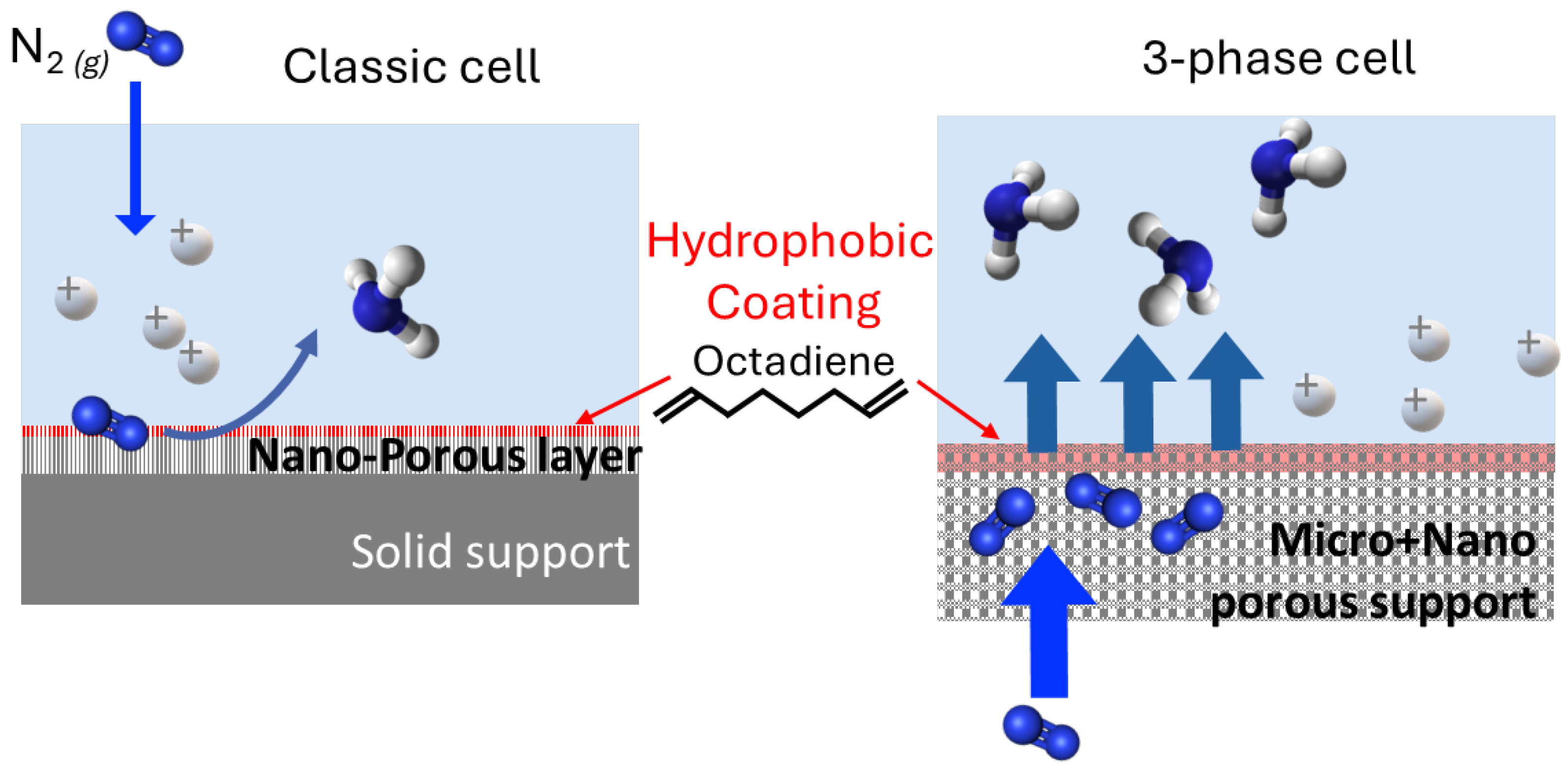


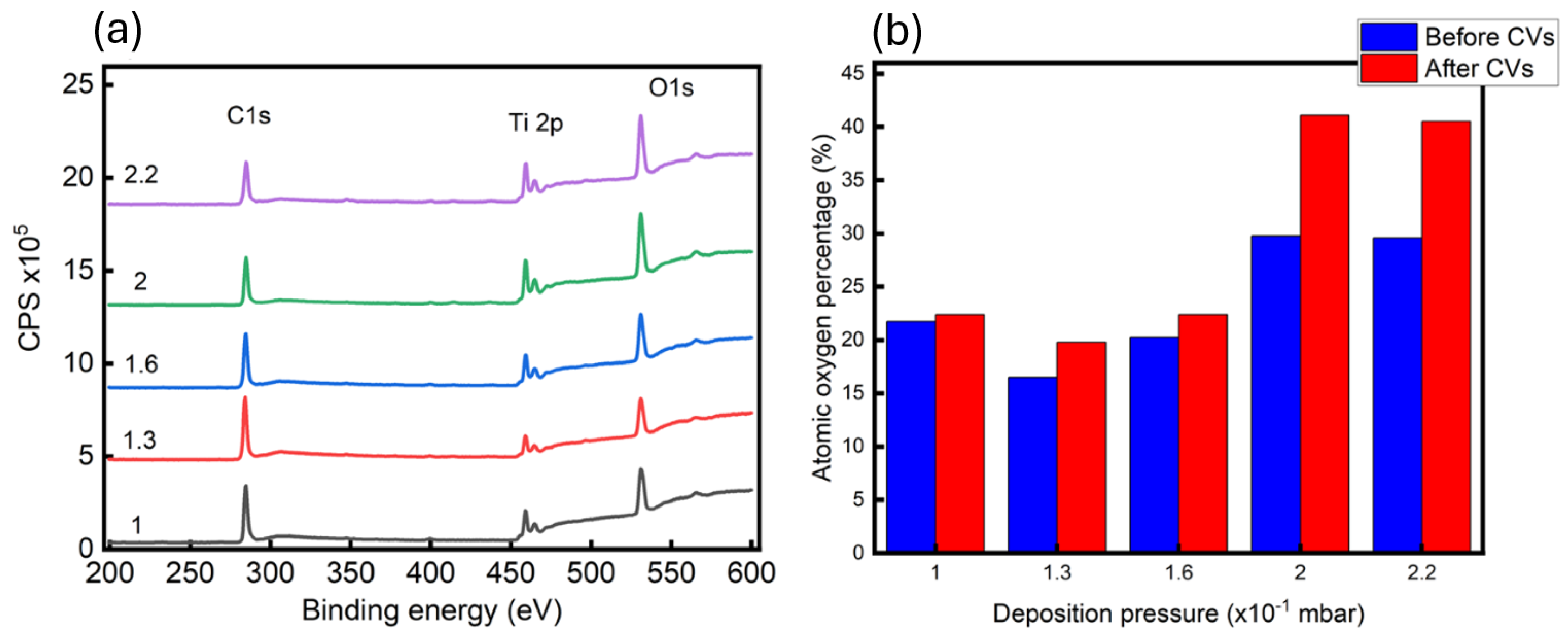
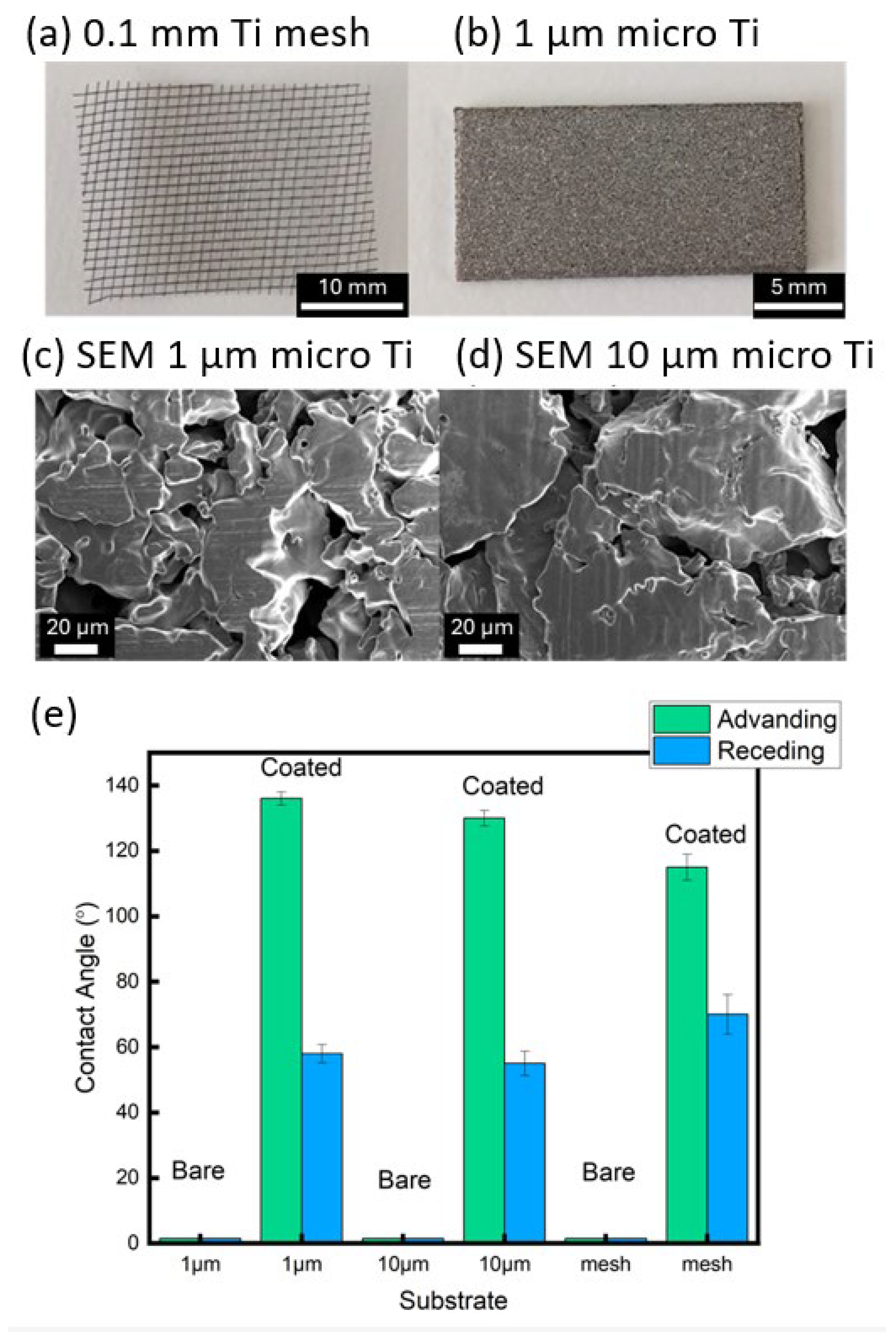
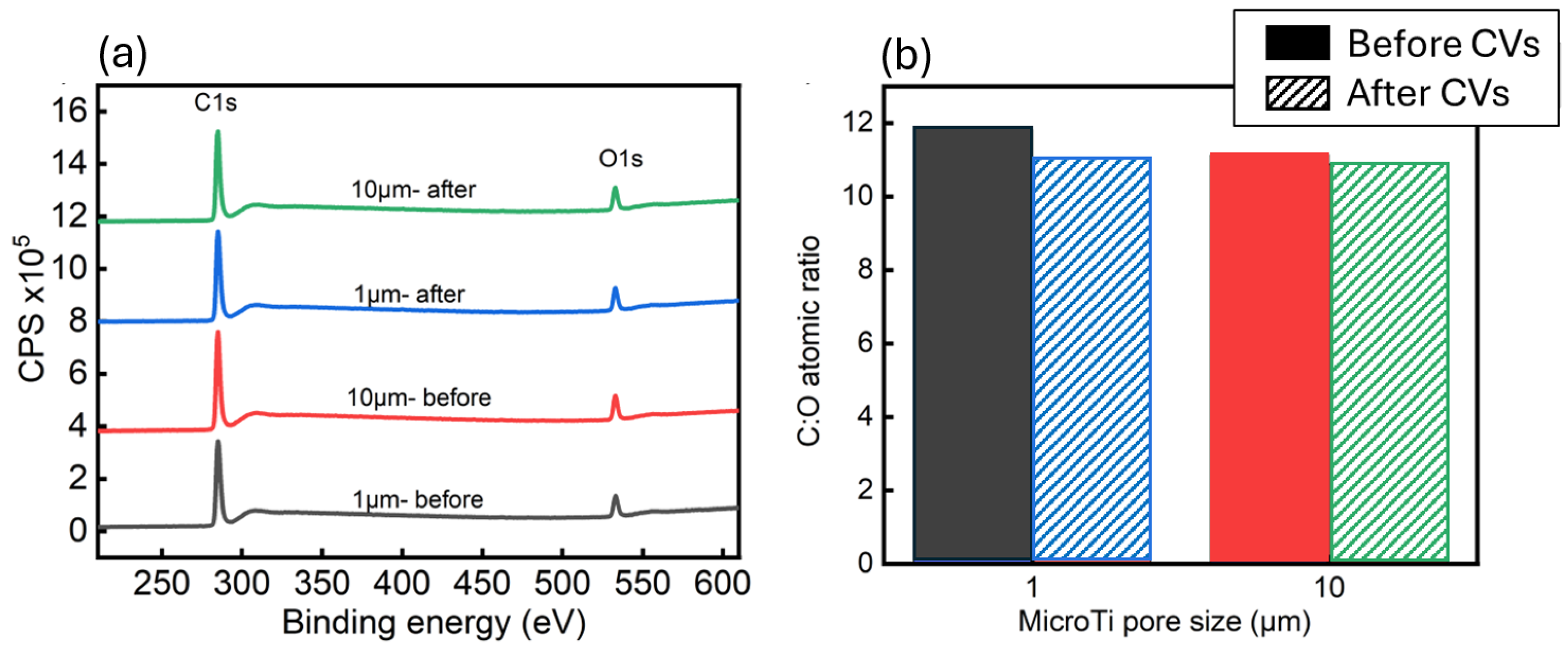

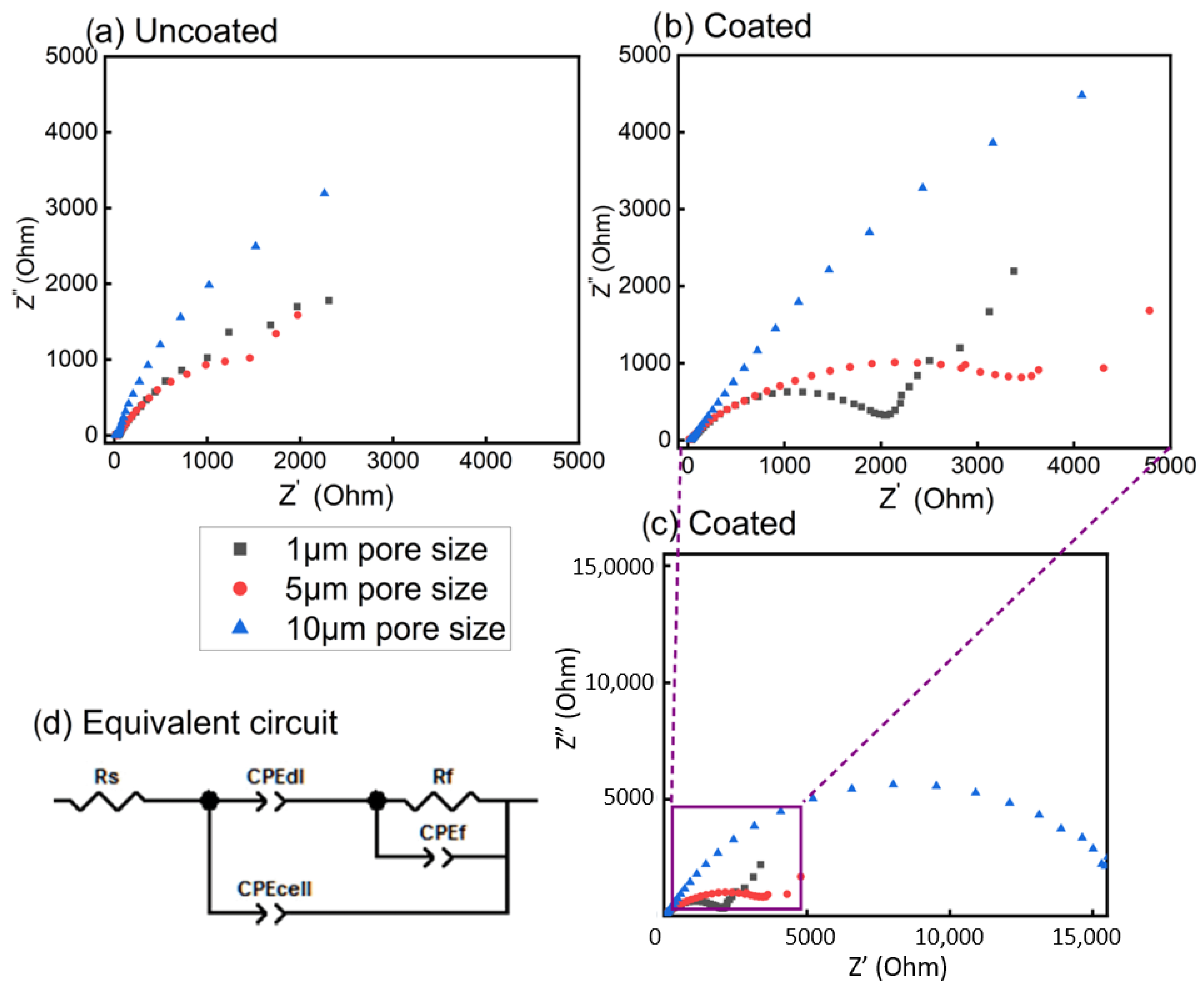
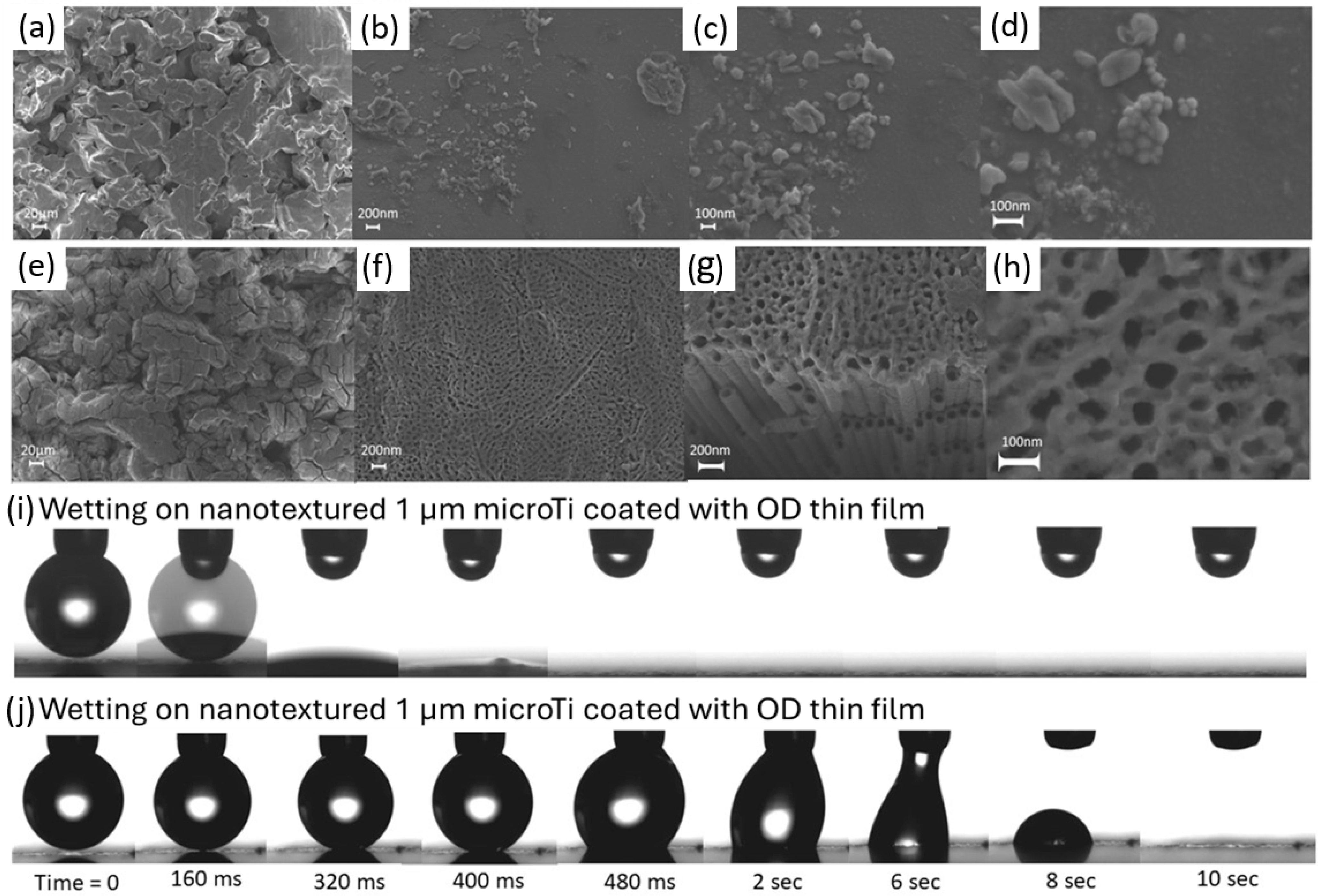
| Parameters | Conditions |
|---|---|
| Base pressure (mbar) | 2.0 × 10−2 |
| Ignition pressure (mbar) | 1.0, 1.3, 1.6, 2.0, 2.2 × 10−1 |
| Power (W) | 5, 10, 20, 30, 40 |
| Time (s) | 30, 60, 90, 120, 150, 180 |
| Substrate | Pore Size | Coated | 1 min Hold | −0.1 V | −0.5 V | −0.75 V | −1 V |
|---|---|---|---|---|---|---|---|
| Micro Ti | 1 μm | no | no | - | - | - | - |
| 1 μm | yes | yes | yes | yes | yes | Yes | |
| 10 μm | no | no | - | - | - | - | |
| 10 μm | yes | yes | yes | yes | no | No | |
| Ti Mesh | 1 mm | no | no | - | - | - | - |
| 1 mm | yes | yes | no | no | no | no |
Disclaimer/Publisher’s Note: The statements, opinions and data contained in all publications are solely those of the individual author(s) and contributor(s) and not of MDPI and/or the editor(s). MDPI and/or the editor(s) disclaim responsibility for any injury to people or property resulting from any ideas, methods, instructions or products referred to in the content. |
© 2024 by the authors. Licensee MDPI, Basel, Switzerland. This article is an open access article distributed under the terms and conditions of the Creative Commons Attribution (CC BY) license (https://creativecommons.org/licenses/by/4.0/).
Share and Cite
Esselbach, G.; Hui, K.W.; Delcheva, I.; Jia, Z.; MacGregor, M. Plasma Coating for Hydrophobisation of Micro- and Nanotextured Electrocatalyst Materials. Plasma 2024, 7, 749-766. https://doi.org/10.3390/plasma7030039
Esselbach G, Hui KW, Delcheva I, Jia Z, MacGregor M. Plasma Coating for Hydrophobisation of Micro- and Nanotextured Electrocatalyst Materials. Plasma. 2024; 7(3):749-766. https://doi.org/10.3390/plasma7030039
Chicago/Turabian StyleEsselbach, Georgia, Ka Wai Hui, Iliana Delcheva, Zhongfan Jia, and Melanie MacGregor. 2024. "Plasma Coating for Hydrophobisation of Micro- and Nanotextured Electrocatalyst Materials" Plasma 7, no. 3: 749-766. https://doi.org/10.3390/plasma7030039








